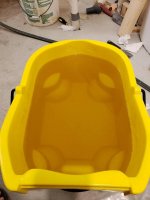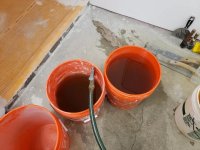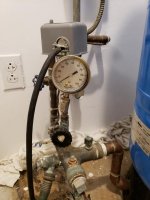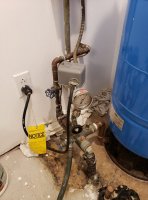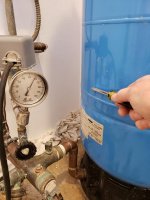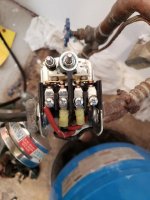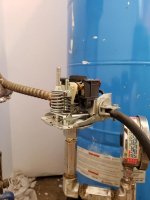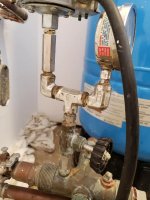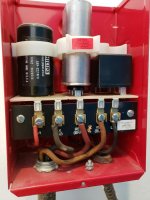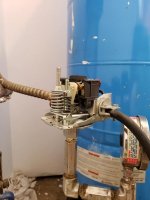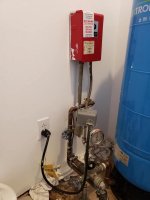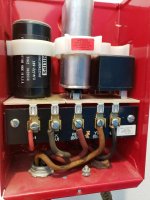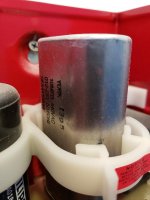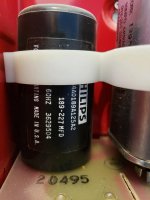I think ideal might be about 7 to 8 gallons to get down to 40, and about another gallon to get to 38.As I understood, 6 gallons was prior to all of the setting adjustments being completed. You then mentioned "9 gallons when I drained it" which I understood to mean 9 gallons drained to reduce the system pressure from 60 psi (pump shut-off) to 40 psi (pump kick-in). The 9 gallons you indicated, is close-enough to the 8.6 gallons drawdown specified in the chart.
You are using an out of date browser. It may not display this or other websites correctly.
You should upgrade or use an alternative browser.
You should upgrade or use an alternative browser.
Iron and manganese removal
- Thread starter Jrland
- Start date
Users who are viewing this thread
Total: 2 (members: 0, guests: 2)
Bannerman
Well-Known Member
The chart specifies 8.6 gallons drawdown is appropriate for the 40/60 pressure range. Since drawdown is the usable capacity for that pressure range, that would not include whatever quantity is related to the 2 psi margin below the cut-in pressure.
As 6 gallons is a substantial variation from 8.6, maybe there is an issue with the pressure tank as Jrland suspected initially. He did mention in post #12 that the tank was substantially heavier prior to draining and refilling it, which suggests a waterlogged tank, which further suggests a failed diaphragm/bladder.
Perhaps if there is a membrane failure, it is only a pinhole so water entered the air chamber slowly over time, which was returned along with air to the water chamber only when the system pressure is below the pressure in the air chamber. As we don't know the initial chosen pressure settings, we don't know if the initial 24-psi pre-charge was related to the previous owner's pressure settings, or due to leakage through the tank membrane.
It was earlier suggested to rotate the tank so the air valve is pointed downward to test if any water exits when the air valve is opened, but it remains unconfirmed if that test was performed. While moving the tank, the weight or sloshing of water within the air chamber will normally be apparent regardless.
As 6 gallons is a substantial variation from 8.6, maybe there is an issue with the pressure tank as Jrland suspected initially. He did mention in post #12 that the tank was substantially heavier prior to draining and refilling it, which suggests a waterlogged tank, which further suggests a failed diaphragm/bladder.
Perhaps if there is a membrane failure, it is only a pinhole so water entered the air chamber slowly over time, which was returned along with air to the water chamber only when the system pressure is below the pressure in the air chamber. As we don't know the initial chosen pressure settings, we don't know if the initial 24-psi pre-charge was related to the previous owner's pressure settings, or due to leakage through the tank membrane.
It was earlier suggested to rotate the tank so the air valve is pointed downward to test if any water exits when the air valve is opened, but it remains unconfirmed if that test was performed. While moving the tank, the weight or sloshing of water within the air chamber will normally be apparent regardless.
Sponsor
Paid Advertisement
Logic tells me that the margin (should be)/ (is) counted. Logic tells you that the margin (should not be)/(is not) counted. Hmmm. One of us should try some calculations if we get inspired. Maybe we can find a technical document to cite.The chart specifies 8.6 gallons drawdown is appropriate for the 40/60 pressure range. Since drawdown is the usable capacity for that pressure range, that would not include whatever quantity is related to the 2 psi margin below the cut-in pressure.
Sounds reasonable to me.As 6 gallons is a substantial variation from 8.6, maybe there is an issue with the pressure tank as Jrland suspected initially. He did mention in post #12 that the tank was substantially heavier prior to draining and refilling it, which suggests a waterlogged tank, which further suggests a failed diaphragm/bladder.
Perhaps if there is a membrane failure, it is only a pinhole so water entered the air chamber slowly over time, which was returned along with air to the water chamber only when the system pressure is below the pressure in the air chamber. As we don't know the initial chosen pressure settings, we don't know if the initial 24-psi pre-charge was related to the previous owner's pressure settings, or due to leakage through the tank membrane.
It was earlier suggested to rotate the tank so the air valve is pointed downward to test if any water exits when the air valve is opened, but it remains unconfirmed if that test was performed. While moving the tank, the weight or sloshing of water within the air chamber will normally be apparent regardless.
Last edited:
LLigetfa
DIYer, not in the trades
If water gets onto the air side, it will often get trapped there and not drain out.
If the OP is draining 9 gallons to get it to zero PSI but only getting 6 gallons of drawdown, something is either wrong with the tank or the methodology. Perhaps the main valve to the house is not getting shut off and the 3 extra gallons are draining from the house plumbing?
If the OP is draining 9 gallons to get it to zero PSI but only getting 6 gallons of drawdown, something is either wrong with the tank or the methodology. Perhaps the main valve to the house is not getting shut off and the 3 extra gallons are draining from the house plumbing?
As I understood, 6 gallons was prior to all of the setting adjustments being completed. You then mentioned "9 gallons when I drained it" which I understood to mean 9 gallons drained to reduce the system pressure from 60 psi (pump shut-off) to 40 psi (pump kick-in). The 9 gallons you indicated, is close-enough to the 8.6 gallons drawdown specified in the chart.
Your pressure tank utilizes 2 separate sections separated by a rubber bladder or diaphragm. One section will contain air and the other section will hold water in varying amounts. Since the air section is pre-charged to 38 psi, there should be only a relatively small quantity of water within the water section when the pump kicks-in at 40 psi. Regardless of the quantity of water the 2 psi represents which will remain constant in the tank, the drawdown (usable) quantity should be close to 9 gallons, not 6 gallons.
https://images.app.goo.gl/TCAsH6jnd1aRytM38
Hi Bannerman. I went through draining the tank again. I'm sending some pics. To get from 60 to 40 psi it took 6 gallons of water discharged then the pump kicked in. After it filled back up, I unplugged it, drained the tank and it seems like there was about 8 1/2 gallons when the water stopped. When I plugged my pump back in, the gauge jumped right to 40 which is really weird. I don't recall that happening with all of the work done the last couple of days. After it got to 60 psi, I discharged water till the pump kicked in, It was a little more than 6 gallons discharged when the pump kicked in at 40. Thanks so much for all of your help!
Attachments
The chart specifies 8.6 gallons drawdown is appropriate for the 40/60 pressure range. Since drawdown is the usable capacity for that pressure range, that would not include whatever quantity is related to the 2 psi margin below the cut-in pressure.
As 6 gallons is a substantial variation from 8.6, maybe there is an issue with the pressure tank as Jrland suspected initially. He did mention in post #12 that the tank was substantially heavier prior to draining and refilling it, which suggests a waterlogged tank, which further suggests a failed diaphragm/bladder.
Perhaps if there is a membrane failure, it is only a pinhole so water entered the air chamber slowly over time, which was returned along with air to the water chamber only when the system pressure is below the pressure in the air chamber. As we don't know the initial chosen pressure settings, we don't know if the initial 24-psi pre-charge was related to the previous owner's pressure settings, or due to leakage through the tank membrane.
It was earlier suggested to rotate the tank so the air valve is pointed downward to test if any water exits when the air valve is opened, but it remains unconfirmed if that test was performed. While moving the tank, the weight or sloshing of water within the air chamber will normally be apparent regardless.
I have a question about a time I drained the tank several years ago. I have 2 hose bibs that are on the line near my tank. One is low, has a hose hooked to it that I use often. The other is about 1/3 of the height of the pressure tank and exits outside. One winter I drained the tank closing up the house. I disconnected power, drained the tank from the low bib and I opened up the higher hose bib until the tank was drained, then closed the valves. When I came back in the spring and turned on power to the pump that is when it seemed that the tank wasn't holding as much water. I have often wondered if I got air stuck in the tank because I had that upper valve open when I drained the tank. That was the only thing I could think was that I drained it improperly. I don't know but have often wondered about it. What do you think?
Attachments
Bannerman
Well-Known Member
Although pressure tank issues are normally discussed in the Pumps, Tanks and Wells forum, you had mentioned your tank issue with regard to its impact on water treatment.
As you previously said the tank is easy to move, if rocking the tank back and forth, can any water be heard or felt in the tank after it has been drained?
Recommend draining the tank again to recheck the pre-charge pressure. Ensure the pump remains off and the water drain faucet remains open, then recheck the precharge pressure again after 30 minutes to determine if there has been any change between the 1st and 2nd check.
It's odd there is an isolation valve (black handle) located between the pump and the pressure switch. Ensure that valve is fully open or remove it completely to ensure it is not obstructing flow and delaying the pressure switch from sensing the system pressure as rapidly as it changes.
It should not make much difference as to which of those faucets was used to drain the tank as the tank does not drain by gravity but the water is pushed out of the tank's bottom port by the pre-charge air pressure pushing against the diaphragm or bladder.
Did all 8.5 gallons flow out at the same speed, or was the final 2.5 gallons slow to collect?there was about 8 1/2 gallons when the water stopped.
As you previously said the tank is easy to move, if rocking the tank back and forth, can any water be heard or felt in the tank after it has been drained?
Recommend draining the tank again to recheck the pre-charge pressure. Ensure the pump remains off and the water drain faucet remains open, then recheck the precharge pressure again after 30 minutes to determine if there has been any change between the 1st and 2nd check.
It's odd there is an isolation valve (black handle) located between the pump and the pressure switch. Ensure that valve is fully open or remove it completely to ensure it is not obstructing flow and delaying the pressure switch from sensing the system pressure as rapidly as it changes.
Some amount of air will enter the water chamber initially, but as the tank pre-charge will deflect the diaphragm or collapse the bladder, the water chamber will be relatively small until filled with water. Any trapped air will eventually diffuse into the water and will be eliminated over time.I have often wondered if I got air stuck in the tank because I had that upper valve open when I drained the tank.
It should not make much difference as to which of those faucets was used to drain the tank as the tank does not drain by gravity but the water is pushed out of the tank's bottom port by the pre-charge air pressure pushing against the diaphragm or bladder.
Last edited:
The chart specifies 8.6 gallons drawdown is appropriate for the 40/60 pressure range. Since drawdown is the usable capacity for that pressure range, that would not include whatever quantity is related to the 2 psi margin below the cut-in pressure.
As 6 gallons is a substantial variation from 8.6, maybe there is an issue with the pressure tank as Jrland suspected initially. He did mention in post #12 that the tank was substantially heavier prior to draining and refilling it, which suggests a waterlogged tank, which further suggests a failed diaphragm/bladder.
Perhaps if there is a membrane failure, it is only a pinhole so water entered the air chamber slowly over time, which was returned along with air to the water chamber only when the system pressure is below the pressure in the air chamber. As we don't know the initial chosen pressure settings, we don't know if the initial 24-psi pre-charge was related to the previous owner's pressure settings, or due to leakage through the tank membrane.
It was earlier suggested to rotate the tank so the air valve is pointed downward to test if any water exits when the air valve is opened, but it remains unconfirmed if that test was performed. While moving the tank, the weight or sloshing of water within the air chamber will normally be apparent regardless.
Although pressure tank issues are normally discussed in the Pumps, Tanks and Wells forum, you had mentioned your tank issue with regard to its impact on water treatment.
Did all 8.5 gallons flow out at the same speed, or was the final 2.5 gallons slow to collect?
As you previously said the tank is easy to move, if rocking the tank back and forth, can any water be heard or felt in the tank after it has been drained?
Recommend draining the tank again to recheck the pre-charge pressure. Ensure the pump remains off and the water drain faucet remains open, then recheck the precharge pressure again after 30 minutes to determine if there has been any change between the 1st and 2nd check.
It's odd there is an isolation valve (black handle) located between the pump and the pressure switch. Ensure that valve is fully open or remove it completely to ensure it is not obstructing flow and delaying the pressure switch from sensing the system pressure as rapidly as it changes.
Some amount of air will enter the water chamber initially, but as the tank pre-charge will deflect the diaphragm or collapse the bladder, the water chamber will be relatively small until filled with water. Any trapped air will eventually diffuse into the water and will be eliminated over time.
It should not make much difference as to which of those faucets was used to drain the tank as the tank does not drain by gravity but the water is pushed out of the tank's bottom port by the pre-charge air pressure pushing against the diaphragm or bladder.
Thanks for all of this information Bannerman. I am going to go through all of the steps you suggest here for evaluation. I started binge watching the worst company videos to understand how this system works and I thank you for the link. I'm including some photos from parts of the system that I checked out before moving on to drain the tank. On the video explaining the wextrol tank, it shows where the diaphragm is installed so I tapped on the tank just above the first weld from the bottom and it sounds hollow as the rest of the tank above each weld. The pressure gauge reads 60psi. I am thinking the volume of water the tank should hold when full would be higher than the first weld. I took the cap off of the switch to investigate and It looks clean. I did notice though that the center spring for the range looks like it is really compressed. I'm wondering if that has anything to do with the amount of water entering the system. I did tighten the differential nut 2 complete turns previously to get the switch to stop at 60 psi. You mentioned that black isolation valve before the switch, Reach4 mentioned it too. I can take that out completely but I have to find a part to replace the height because my wiring won't reach. On a side note, looking at the switch it seems odd that there is no ground from the motor or the control box. The only ground is from my plug to the switch. Thanks for all of your help.
Attachments
You usually don't want to do that. Tightening the differential nut increases the difference between cut-in and cut out. 20 psi is suggested for most uses. That usually corresponds to an almost loose spring.I did tighten the differential nut 2 complete turns previously to get the switch to stop at 60 psi.
Do you have any remaining symptoms, other than wishing that you could use more than 6.5 gallons without the pump cutting on? Recapping symptoms would be good.
Your left contacts on the pressure switch look a little bent, but I see no reported symptom resulting from that.
Is your control box (maybe Red Jacket) for a 3-wire pump still in the circuit? If so, know that starting capacitors have limited life. It can be good to replace those maybe every 8 years or so. The symptom would be slow or no-start, and maybe the breaker tripping.
You usually don't want to do that. Tightening the differential nut increases the difference between cut-in and cut out. 20 psi is suggested for most uses. That usually corresponds to an almost loose spring.
Do you have any remaining symptoms, other than wishing that you could use more than 6.5 gallons without the pump cutting on? Recapping symptoms would be good.
Your left contacts on the pressure switch look a little bent, but I see no reported symptom resulting from that.
Is your control box (maybe Red Jacket) for a 3-wire pump still in the circuit? If so, know that starting capacitors have limited life. It can be good to replace those maybe every 8 years or so. The symptom would be slow or no-start, and maybe the breaker tripping.
Hi reach4. You are right that figuring this out has been quite involved and could use a recap. lol Originally my tank switch would kick in after about 2 gallons of water was discharged. At that same time to empty the tank there was only 3 gallons of water when it was empty. After much discussion and adjustments made, pressure in the tank raised from 24 to 38 and the differential nut turned 2 turns to make the range 40/60, that increased the amount of water my tank would hold and also allowed 6 gallons of water discharged before the switch hit 40 and the pump kicked in. Upon taking these pictures to show bannerman, I noticed that the center spring looked very compressed and I am now wondering if the original owner had tightened that nut for some reason and that may be why I needed to tighten the differential nut. When I bought the house it was known that the pressure tank was bad and needed replacement. I did that first thing. No adjustments were ever made to the switch after I took possession of the house so I don't know if perhaps the previous owner monkeyed with the switch to accommodate a defunct tank. That is why I am wondering if I need to loosen up that center spring and turn the differential nut back 2 turns. On the videos that I watched about the switches, the center spring isn't compressed as much as mine is. Thanks for all of your help.
Attachments
Pressure switches are pretty reasonable (around $20 to 30). You have that extra isolation valve that would let you change the switch without draining the system, if you like. Remember breaker must always be off when that valve is closed.Upon taking these pictures to show bannerman, I noticed that the center spring looked very compressed and I am now wondering if the original owner had tightened that nut for some reason and that may be why I needed to tighten the differential nut.
That Red Jacket control box is for a 115 volt pump. Your pressure switch appears to be wired for 240 (230). So that control box may not be in the circuit now, and the old 3-wire pump may have been replaced by a 2-wire pump. Is your breaker a 2-pole breaker or 1-pole?
So, to recap your remaining symptoms, I think it's really only that you don't use as many gallons after the pump shuts off until it comes on again as you would like. How many seconds does your pump run at minimum?
Pressure switches are pretty reasonable (around $20 to 30). You have that extra isolation valve that would let you change the switch without draining the system, if you like. Remember breaker must always be off when that valve is closed.
That Red Jacket control box is for a 115 volt pump. Your pressure switch appears to be wired for 240 (230). So that control box may not be in the circuit now, and the old 3-wire pump may have been replaced by a 2-wire pump. Is your breaker a 2-pole breaker or 1-pole?
So, to recap your remaining symptoms, I think it's really only that you don't use as many gallons after the pump shuts off until it comes on again as you would like. How many seconds does your pump run at minimum?
Interesting Reach4. I'm pretty sure the pump was replaced at some point before I bought the house. It was from an estate with no information available. When I rewired the house, I wired the well exactly as it was when I bought it. 1 single pole 20 amp circuit to a dedicated outlet that can be unplugged to kill the power to the pump. Do you think the red jacket box is used as an interface between the pump wiring and the switch wiring? So with that some of the components in the box aren' t currently being used?
I totally gutted this house and replaced all of the utilities. In all this time during rehab, I have only used a bucket of water for construction or to flush a toilet. I am looking at water treatment systems because I am ready to put this house in service. It seems that putting an actual demand on the tank and pump as it is running now would be a problem. I have the 32 gallon WellxTrol tank #WX-203. The specs say I should have 8.5 gallons on a drawdown and I still haven't figured out how many actual gallons the tank is supposed to hold. I should have more than 8 gallons on a full tank and 6 gallons on a draw down. With the help from you and bannerman, that was an improvement from 4 gallons on a full tank and 3 gallons on a draw down.
It currently takes 42 seconds for the pressure switch to go from 40 to 60.
So what you've said is that it might be good just to change the switch that would have the original factory settings?
Attachments
Bannerman
Well-Known Member
The outlet your pump obtains power from, is rated for up to 125 volts, 20 amps. If it was approved for 220-240 volts 20 amps, the right connection slot (when ground opening is at bottom) would be horizontal, not vertical.
In using the Amtrol Well-X-Trol Selection Tool, the appropriate tank specified is a WX-205 to obtain 60 seconds minimum pump run time for a pump delivering 9 or 10 gpm @40/60 psi.
Although the WX-205 total tank capacity is only 2 gallons greater than the WX-203, the Maximum Acceptance Factor is substantially higher at 1.00 for the WX-205 compared to 0.35 for the WX-203, which means a greater portion of the WX-205 total tank capacity will be utilized to contain water.
For 120 seconds pump minimum run time, the WX-251 or WX-255 tanks are specified. 2-minutes minimum run time is often beneficial, particularly when the pump is 3/4 HP or higher.
Since the pressure tank Quick Sizing chart referred to earlier was based on the specifications for a Flexcon Challenger PC111- 32 gallon tank, it appears that chart is not suitable for Well-X-Trol WX series tanks.
The ground wire should be connected to the outer metal case for the pressure switch, while also connected to the pump controller and pump casing.
In using the Amtrol Well-X-Trol Selection Tool, the appropriate tank specified is a WX-205 to obtain 60 seconds minimum pump run time for a pump delivering 9 or 10 gpm @40/60 psi.
Although the WX-205 total tank capacity is only 2 gallons greater than the WX-203, the Maximum Acceptance Factor is substantially higher at 1.00 for the WX-205 compared to 0.35 for the WX-203, which means a greater portion of the WX-205 total tank capacity will be utilized to contain water.
For 120 seconds pump minimum run time, the WX-251 or WX-255 tanks are specified. 2-minutes minimum run time is often beneficial, particularly when the pump is 3/4 HP or higher.
Since the pressure tank Quick Sizing chart referred to earlier was based on the specifications for a Flexcon Challenger PC111- 32 gallon tank, it appears that chart is not suitable for Well-X-Trol WX series tanks.
The ground wire should be connected to the outer metal case for the pressure switch, while also connected to the pump controller and pump casing.
Last edited:
The outlet your pump obtains power from, is rated for up to 125 volts, 20 amps. If it was approved for 220-240 volts 20 amps, the right connection slot (when ground opening is at bottom) would be horizontal, not vertical.
In using the Amtrol Well-X-Trol Selection Tool, the appropriate tank specified is a WX-205 to obtain 60 seconds minimum pump run time for a pump delivering 9 or 10 gpm @40/60 psi.
Although the WX-205 total tank capacity is only 2 gallons greater than the WX-203, the Maximum Acceptance Factor is substantially higher at 1.00 for the WX-205 compared to 0.35 for the WX-203, which means a greater portion of the WX-205 total tank capacity will be utilized to contain water.
For 120 seconds pump minimum run time, the WX-251 or WX-255 tanks are specified. 2-minutes minimum run time is often beneficial, particularly when the pump is 3/4 HP or higher.
Since the pressure tank Quick Sizing chart referred to earlier was based on the specifications for a Flexcon Challenger PC111- 32 gallon tank, it appears that chart is not suitable for Well-X-Trol WX series tanks.
The ground wire should be connected to the outer metal case for the pressure switch, while also connected to the pump controller and pump casing.
Thanks Bannerman. I have to digest some of the info you said here to understand it all. I did look up the spec chart today for the wellxTrol tank and saw that it recommended WX-205.
I just completed the steps again as you suggested. I had 44.47 seconds for the pressure switch to go from 40 to 60. I drained it, there was 8 gallons total. I tested the tank pressure it was 38. I tested the tank pressure again 2 hours later it was 38. The valve is left open and I hear no water at the bottom of the tank.
From the sound of what your saying is that between my pump, switch and well tank, I have a system that is incompatible to run appropriately. I'm wondering if I can even assume that the sticker on the red jacket box is actually the pump that is in my well. I'm guessing there is no way to tell without pulling the pump from the well. Please tell me I'm wrong....
The outlet your pump obtains power from, is rated for up to 125 volts, 20 amps. If it was approved for 220-240 volts 20 amps, the right connection slot (when ground opening is at bottom) would be horizontal, not vertical.
In using the Amtrol Well-X-Trol Selection Tool, the appropriate tank specified is a WX-205 to obtain 60 seconds minimum pump run time for a pump delivering 9 or 10 gpm @40/60 psi.
Although the WX-205 total tank capacity is only 2 gallons greater than the WX-203, the Maximum Acceptance Factor is substantially higher at 1.00 for the WX-205 compared to 0.35 for the WX-203, which means a greater portion of the WX-205 total tank capacity will be utilized to contain water.
For 120 seconds pump minimum run time, the WX-251 or WX-255 tanks are specified. 2-minutes minimum run time is often beneficial, particularly when the pump is 3/4 HP or higher.
Since the pressure tank Quick Sizing chart referred to earlier was based on the specifications for a Flexcon Challenger PC111- 32 gallon tank, it appears that chart is not suitable for Well-X-Trol WX series tanks.
The ground wire should be connected to the outer metal case for the pressure switch, while also connected to the pump controller and pump casing.
Also, the water discharges at the same speed until the tank is empty. Thanks for your help.
Does the pressure switch get wired to the box and the box gets wired to the pump? If yes, I would presume the box is in use.Interesting Reach4. I'm pretty sure the pump was replaced at some point before I bought the house. It was from an estate with no information available. When I rewired the house, I wired the well exactly as it was when I bought it. 1 single pole 20 amp circuit to a dedicated outlet that can be unplugged to kill the power to the pump. Do you think the red jacket box is used as an interface between the pump wiring and the switch wiring? So with that some of the components in the box aren' t currently being used?
I think you are pretty close to normal, and should be close to declaring victory.The specs say I should have 8.5 gallons on a drawdown and I still haven't figured out how many actual gallons the tank is supposed to hold. I should have more than 8 gallons on a full tank and 6 gallons on a draw down.
This is just an idea if you want to study further: What pressure are you at when the pressure switch clicks off, 5 seconds after the pump stops running? What is the pressure when the pressure switch clicks on? And if you turn off the pump, and run a faucet to let the pressure slowly drop, what is the pressure just before the pressure drops quickly? A movie that you could step through slow-motion can be useful to see that.
Bannerman
Well-Known Member
Since the WX-205 is the recommended minimum tank size for your 9-10 gpm pump @ 40/60 psi, and as there appears to be no leakage through the diaphragm, it seems 6 gallons might be the maximum drawdown possible with your WX-203 tank when operating at 40/60 psi.
What seemed odd was 6 gallons drawdown, but 9 gallons drained. While some additional water in addition to drawdown is usual, 50% more seems unusual which lead to the question of a possible membrane failure.
The Well-X-Trol Selection Tool specifies the WX-203 will be suitable to achieve 60 seconds minimum pump run time for a 9-10 gpm pump when the operating pressure is reduced to 30/50 psi, which was likely the original design pressure range setting for your pressure switch.
What seemed odd was 6 gallons drawdown, but 9 gallons drained. While some additional water in addition to drawdown is usual, 50% more seems unusual which lead to the question of a possible membrane failure.
The Well-X-Trol Selection Tool specifies the WX-203 will be suitable to achieve 60 seconds minimum pump run time for a 9-10 gpm pump when the operating pressure is reduced to 30/50 psi, which was likely the original design pressure range setting for your pressure switch.
Since the WX-205 is the recommended minimum tank size for your 9-10 gpm pump @ 40/60 psi, and as there appears to be no leakage through the diaphragm, it seems 6 gallons might be the maximum drawdown possible with your WX-203 tank when operating at 40/60 psi.
What seemed odd was 6 gallons drawdown, but 9 gallons drained. While some additional water in addition to drawdown is usual, 50% more seems unusual which lead to the question of a possible membrane failure.
The Well-X-Trol Selection Tool specifies the WX-203 will be suitable to achieve 60 seconds minimum pump run time for a 9-10 gpm pump when the operating pressure is reduced to 30/50 psi, which was likely the original design pressure range setting for your pressure switch.
Thanks for all of your input and help here. I'm going to see what I can figure out. I'll start researching this pump today. Have a great day!
Similar threads
- Replies
- 0
- Views
- 377
- Replies
- 1
- Views
- 542
- Replies
- 10
- Views
- 1K
- Replies
- 5
- Views
- 839

